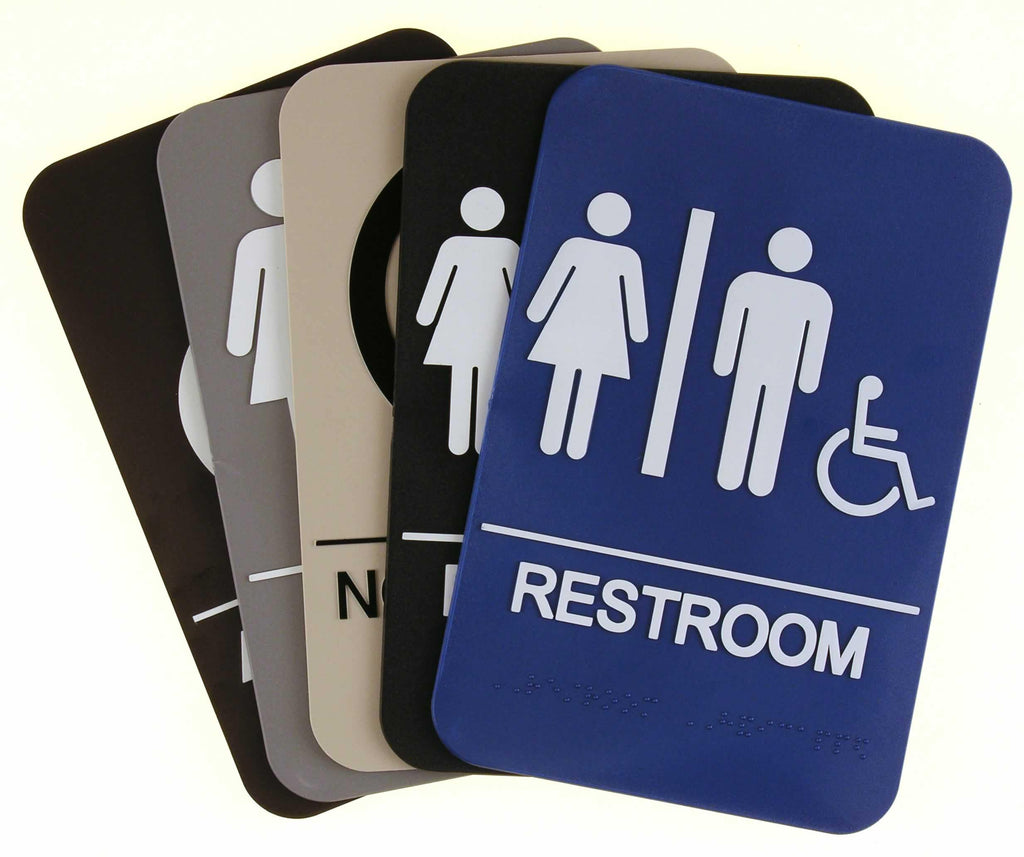Recognizing the Regulations Behind ADA Signs
Recognizing the Regulations Behind ADA Signs
Blog Article
ADA Signage: Guaranteeing Access and Conformity in Public Spaces
ADA signs plays a vital duty in assuring ease of access and conformity within public rooms, substantially adding to an inclusive setting for people with impairments. By sticking to ADA standards, signage not just promotes navigating but additionally highlights a company's commitment to variety and equal rights. As we check out the subtleties of ADA signs, from tactile functions to develop complexities, it's crucial to think about exactly how these elements coalesce to copyright the legal rights of all customers. What are the usual mistakes organizations deal with in maintaining compliance, and just how can future trends in signage continue to drive ease of access ahead?
Value of ADA Signage
In contemporary culture, the relevance of ADA signage prolongs beyond plain conformity with legal requireds to symbolize a commitment to inclusivity and ease of access for all individuals. These indications are crucial in developing settings where individuals with specials needs can browse public spaces with the very same simplicity and freedom as those without disabilities. By providing standard and clear info, ADA signs makes sure that every person can access facilities, services, and info without obstacles.
The importance of ADA signage lies in its capacity to boost the quality of life for people with handicaps by advertising equivalent gain access to. It gets rid of the barriers that might or else hinder their capability to take part completely in community life. These indicators offer as noticeable signs of an organization's devotion to variety and equal rights, mirroring wider social values that promote the rights and dignity of all people.
Additionally, ADA signs plays an essential role in public safety. By directing people to leaves, washrooms, and other necessary centers, it makes sure that all people, no matter physical ability, can evacuate safely throughout emergencies. In recap, ADA signage is not just a governing need yet an effective tool for promoting a inclusive and equitable society.
Crucial Element of Compliance

Placement is important; indications must be mounted in places that are obtainable and conveniently visible. Usually, signage ought to be placed between 48 and 60 inches from the ground to make sure accessibility for both standing and mobility device users. Tactile elements, such as Braille, are essential for people with aesthetic impairments, supplying important info in a non-visual style.
High-contrast colors between the text and background are needed to enhance readability for individuals with low vision. The ADA mandates details comparison ratios to ensure clarity. Furthermore, personality dimension is a crucial factor to consider, with minimal elevation needs dictated by the checking out range to guarantee readability from different angles.
Style Considerations for Access
Creating available signs calls for a precise approach to ensure it meets the requirements of all customers, especially those with impairments. The dimension of the message is equally essential, with ADA standards suggesting a minimum height based on seeing range to make certain readability.
Contrasting shades in between message and background are crucial for visibility, especially for individuals with visual impairments. Furthermore, tactile components, such as Braille and raised characters, are vital for individuals who are blind or have reduced vision.
Additionally, the positioning of signs plays a significant role in ease of access. Indications must be installed in areas that are easily reachable and unobstructed. Making sure that signage is placed at proper heights and angles allows all users, including those utilizing wheelchairs, to engage with them efficiently.
Typical Errors to Avoid

An additional common mistake is the wrong positioning of signs. ADA standards define accurate elevation and area needs to make certain that indications visit the website are reachable and quickly noticeable by all individuals, consisting of those utilizing mobility devices. Neglecting these standards not just obstructs accessibility but additionally runs the risk of non-compliance with legal standards.
Furthermore, insufficient contrast in between text and history is a constant oversight. Adequate comparison is essential for readability, especially for individuals with reduced vision. Developers often pick shades that are aesthetically enticing yet do not have the necessary comparison, providing the text challenging to discern.
Lastly, some designers stop working to incorporate responsive aspects, such as Braille, which are critical for individuals that are blind. Omitting these attributes not just leads to non-compliance with ADA policies however likewise limits gain access to for a sector of the populace that relies upon responsive details.
Future Trends in Signage
Advancements in innovation and increasing awareness of inclusivity are forming the future fads in signage layout. Digital signage, for circumstances, is advancing to consist of real-time updates and interactive functions, which can be essential in giving vibrant information in public rooms.
An additional emerging trend is the utilization of enhanced fact (AR) to enhance user experience. AR-enabled signage can overlay electronic details onto the physical environment, offering aesthetically impaired individuals hop over to here with auditory or haptic feedback. ADA Signs. This modern technology not just improves accessibility however also creates an appealing experience for all customers
Sustainability is additionally a considerable factor affecting signage trends. Green products and energy-efficient lights remedies are being focused on to align with international environmental goals. Furthermore, advancements in products scientific research are leading to the advancement of even more weather-resistant and long lasting signs.
Conclusion
ADA signage plays a crucial role in assuring availability and conformity within public areas by incorporating responsive elements, high-contrast shades, and calculated placement. The adherence to ADA standards not just helps with safe navigating for individuals with disabilities but also represents a company's commitment to variety and inclusivity. By preventing usual mistakes and embracing future patterns, public spaces can continue to advance these values, making sure that the rights and dignity of all individuals are appreciated and supported.
ADA signage plays an indispensable function in assuring ease of access and compliance within public rooms, dramatically adding to an inclusive setting for people with disabilities. As we explore the subtleties of ADA signs, from tactile attributes to develop ins and outs, it's vital to consider just how these aspects integrate to promote the civil liberties of all customers.In contemporary culture, the value of ADA signs extends past mere conformity with lawful requireds to symbolize a commitment to inclusivity and availability for all individuals. By supplying clear and standardized details, ADA signs guarantees that every person can access facilities, solutions, and information without barriers.
ADA signage plays a crucial role in guaranteeing accessibility and compliance within public spaces by integrating tactile elements, high-contrast shades, and strategic placement. (ADA Signs)
Report this page